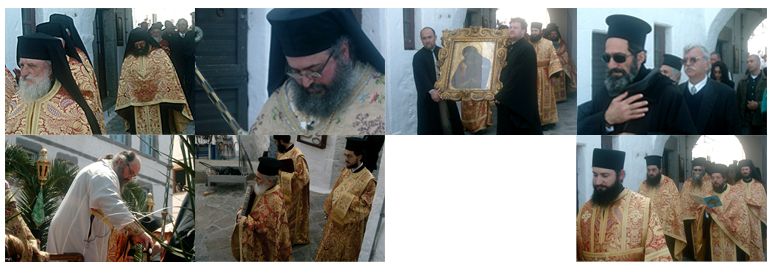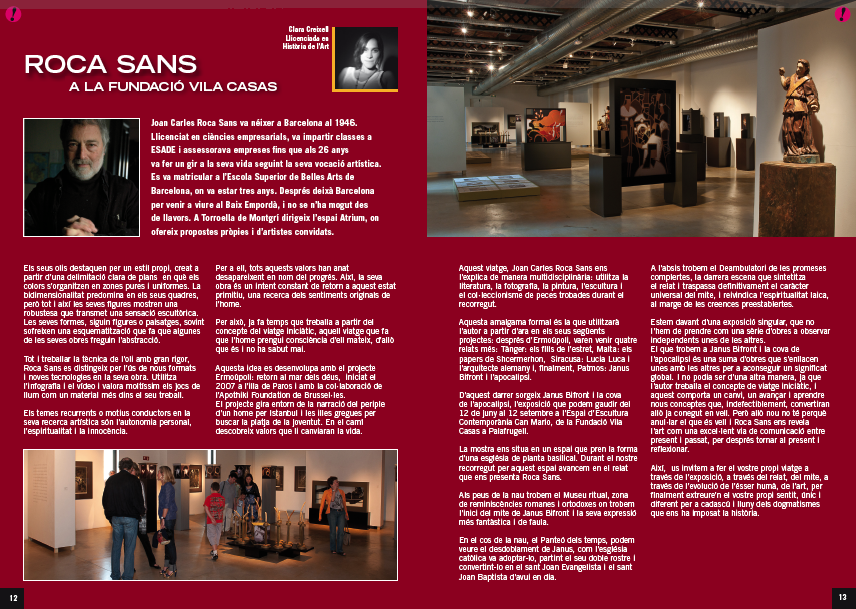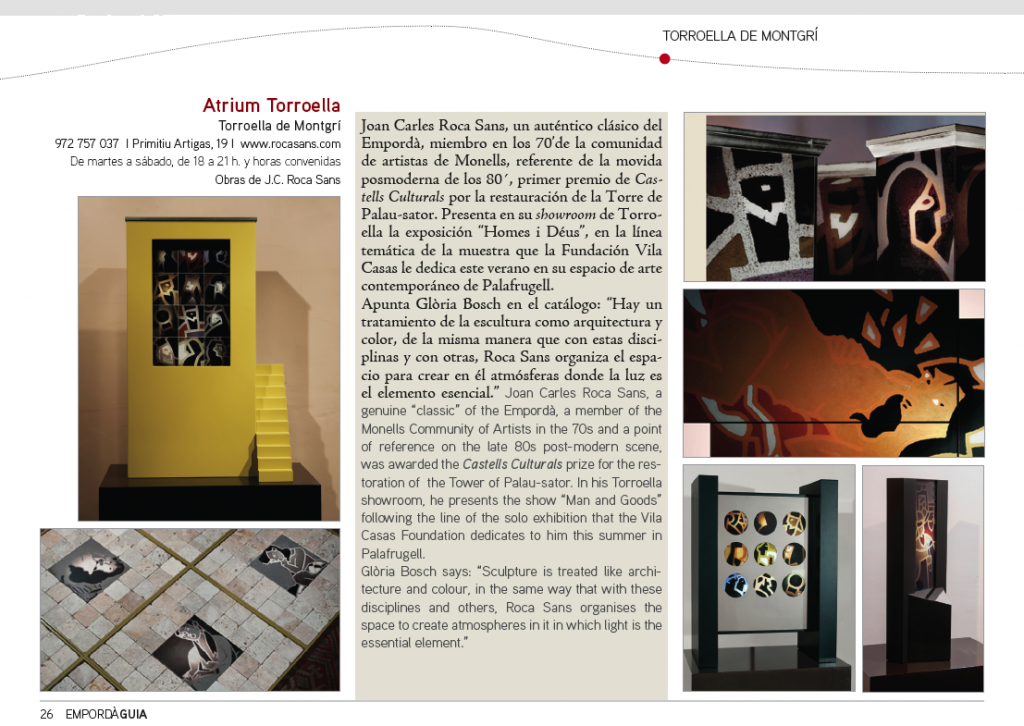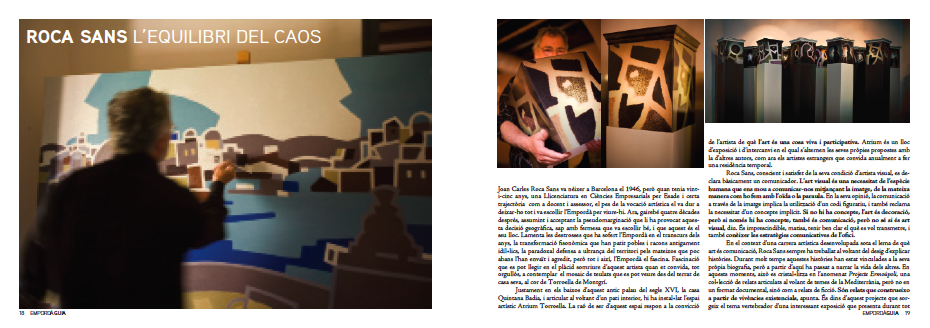
PATMOS (GREECE). TWO-FACED JANUS AND THE APOCALYPSE
Adaptation of the homonym tale by Joan C. Roca Sans
Tears of non-existence
Suffering is the most powerful revealing experience and David had known for a long time that he would have to suffer to be able to paint and that only this suffering would develop his talent. He continued to feed the idea of harmony: the principle of virtue raised on aesthetic foundations, the principle of proportionality that tries to approach beauty.
This had always been “his idea”, a Greek idea par excellence that covered a span which went from Plato through to Plotinus and, like a Kantian corollary reached as far as Alan Greenberg, the great Informalism theorist, to be disputed with the arrival of contemporary art.
Heading for the island of Patmos (Dodecanese-Greece)
“When you hear three blasts of the siren like these” —three gloomy honks could be heard— “please go to the meeting places signalled on the information panels” a recorded voice announced first in Greek, then in English, and then again in Greek.
The Greek passengers carried on resting, sprawled on the seats and on the floor, covered with jackets or travel rugs, used to this life-saving drill, but the foreigners milled around, visibly concerned, near the exits to the bridge, while the shipping company steward demonstrated how to use the life jacket.
In the Royal Holy Monastery of St. John the Theologian and Evangelist
The lights of Skala Port started to become visible through the reassuring fog the enveloped the island of Patmos and David started to experience the fascination that always comes with the certainty of immediate landing at a new port. At moments like this, he felt like a true nomad, who finds no satisfaction in staying, but in arriving and departing, the only acts able to fight, through their very fleetingness, against the transitory nature of existence.
Everyone greeted each other with kisses for Easter. Everywhere, you could hear Cristos Anesti, in Greek: Christ has risen. The church bells mixed with the sirens of the boats that were moored in the port, while fireworks lit up the Monastery, on the crest of the hill, with a twinkling crown of coloured sparks.
In the Apocalypse Cave
They shook hands and Zouveloc greeted him saying. “Hello David, Father Stavros has told me you’re an artist. I’m very interested in art personally because it is the best, most profund way of living with our abysmal ignorance. At least art stays alive and the artist seeks the experience of what is sacred within him. Parmenides also looked for an expression of a beautiful form to tell us his harmonic idea of the Being of the world.
Harmony, poetry, aesthetics and passion for explaining and organising the chaos: this is Greece. Welcome, my friend.”
“Although I don’t share your posture, you are not mistaken, David, because all true mystics, as mystics, are agnostics in what they do to the dogmatic contents of any form of religion.”
“I’m fascinated by the world of your predecessors because we will never be able to be sure that what they told us was true. When you read all those poets, you always wonder what truth is, where reality resides, where life begins and where dreaming ends.”
“It’s possible” David admitted “but in view of everything we have been talking about, I think that St. John is nothing more than a substitute for the Roman god Janus Bifrons who, with his two profiles, symbolised eternity as he was able to look into the future and into the past.
John the Baptist would then be the messenger, the oracle, the one who anticipated the future, while John the Evangelist would be the one who witnessed the great story of Christ and was able to explain it. It all fits in perfectly.
“Yes, we are creatures that like constructing stories.” Zouveloc continued, “But we know they are only stories. You artists are mystical rather than rational and reach conclusions that logic cannot arrive at.
“On one occasion”, he explained “I loved a woman who, varying between unpredictable behaviour and infinite goodness, showed me the paradoxical light of darkness. She made clothes, sang while she sewed and in any everyday activity, she was at one with the present, the present in which there is never death.”
“One day, however, for a few moments she forgot the wisdom of knowing how to live in the present. On rushing to greet me, she unwittingly activated the garage door with the remote control that was hanging at her waist. On what might have been the happiest day of her life, she met her death in the most tragic, unexpected way.” She was 42 years old.
Father Stavros and Costas A. Zouveloc listened to him in silence, a silence that was as deep as the blue of the Aegean Sea that washed around the island.
© JC Roca Sans 2009
Instalation Video
EXHIBITION AT THE
CAN MARIO MUSEUM OF THE VILA CASAS FOUNDATION
Can Mario Museum. Palafrugell (Summer 2010)

Download the full Catalog:

OPENING
EXHIBITION
THE COUNTER STORY OF A MYTH
by Glòria Bosch
Unlike what is usually said, the future is already written,
what we do not know is how to read its pages,
Cain said, while asking himself where he had got this revolutionary idea from…
José Saramago. Caín, 2009
The project that Joan Carles Roca Sans proposes is an initiation journey, the construction of a story that subverts the concept of certainty and emerges as a staging carried out in three times, in which he includes the dialogue between some of the popular carvings, which came from antiquarians, which he has collected over the years and the selection that he has made of his own work to organise a proposal, which is the story and counter story of Two-Faced Janus in the Apocalypse Cave. A trip which starts and ends in a way totally opposite from the concept that one usually has of travelling today, far removed from the overcrowded recurrences that are intent on repeating themselves without leaving room for questions, mystery, personal experience and, above all, the desire to convert oneself into the explorer of one’s own internal and emotional needs.
If Saramago demystifies in his story about Cain, Roca Sans also does so when taking apart the myth of St John and bringing us closer to a world in which not only the future but also the past can be written, and in which the problem is always about “how to read the pages”. Through art, thought or literature, we can access the light that is hidden on the pages, a learning which —instead of closing— opens up to the individual experience of each person. And he, through David, the painter who does not agree with a society “that denies the spiritual categories of creation and artistic contemplation” offers us his own experience of travelling around a mystery, a story created —using fiction— to guide us towards a counter story about the myth, to invert the dogmatic and strategic codes that religions usually use, to find the origin in this Two-Faced Janus that leads us to his image split into two by Christianity, because the role of the mystic, as one of its characters points out, ends up being that of the agnostic.
The show suggests this dialogue with carvings from an author’s collection, however the way in which he achieves a whole series of complicities related to everything he wants to tell us, obeys artistic and creative criteria that erase the fact that they are objects preliminary to worship. Despite his reflection on the ritual elements, on how time controls meanings to fill them with content and also the search for features that are common to different religions, his aim is to question and to open up possibilities. Following the line of Pessoa who feared men full of certainty or of Saramago who unifies human contradiction as if everything responded to the two sides of the same coin, he —to follow the thread of his narration— needs to specify it through staging registers.
From where does he explain his multi-disciplinary story? This Two-Faced Janus in the Apocalypse Cave is created in the field work of Joan Carles Roca Sans who, like an anthropologist, compiles notes, the beginnings of a fragmentary visual construction that, little by little, takes on shape as if it were a fiction story. Sculpture is treated like architecture and colour, in the same way that with these disciplines and others, he organises the space to create atmospheres in it in which light is the essential element. The constructive meaning, between the drawing, painting, photography and digital technology, is always present in his creative world and it is from here that they relate, tighten and balance the various components to achieve the textures, the veiling or the diverse visual effects. It is not surprising that buildings appear such as temples, stairs and so on; that he is interested in a reversal of the image, in the photographs which have two faces, two sides to view or that three versions can be made of a single drawing depending on the context in which he wishes to integrate it, with a diversity of treatments and colours. The resources are broad and in some cases, such as Torre Blava and Torre Roja, the image unfolds itself in the triangle that is the base of the structure, with a mirror effect that even integrates the spectator. All the works created for the exhibition, some fifty of them, are unique pieces, because although he goes back to work on the same file, there are multiple variations and finishes. Although for many it could seem to be contradictory, digital tools allow to give this unique character to each piece.
The exhibition allows us to “travel” through three differentiated areas over time: Museu del Ritual, El Panteó del Temps and Deambulatori de les promeses complertes, the last scene that synthesises the story and definitively transfers the universal character of a myth, a way of vindicating secular spirituality aside from established beliefs. Altogether, with knowledge about it and a good sense of irony, he takes a poke at the myth of Salomé as if he were Flaubert, Wilde or Beardsley, among others. However, before reaching the end of the route to all meet together at the Columnari del Palau d’Herodes, he has taken us through many concepts of worship, through the purifying ritual bath –with six basins each dedicated to a different nymph— through philosophers, obedience, offerings, relics, towers of fire, processions, the tombs of the Panteó del temps —between men and gods—or through mosaics.
The opening and breaking down of barriers coincides both with regard to his concept of work as to his philosophy, it does not matter whether we talk about visual contents or about the results that he achieves when relating apparently contradictory practices to find the point that “allows us to go through the surfaces to oblige them to show their two faces, which is the same as revealing what is real”. What Joan Carles Roca Sans achieves is that, with the excuse of spinning out a story, he enters into the combination of a whole series of elements that are to do with the way of facing and taking on not just a way of thinking and feeling but of understanding creative work, just where the dogmatic linearity breaks, which, as it is new, must eliminate what is old without realising that art, as an existential trip, is a timeless bridge to the past and back to the present, to reflect and to update from each point of arrival, not forgetting the transitory nature that makes us start over again.
-
Download Revista Costa Live PDF (click on image below)
-
Download Revista Guaita PDF (click on image below)
-
Download Emporda Guia PDF (click on image below)
-
Download Emporda Guia Report PDF (click on image below)




























































































